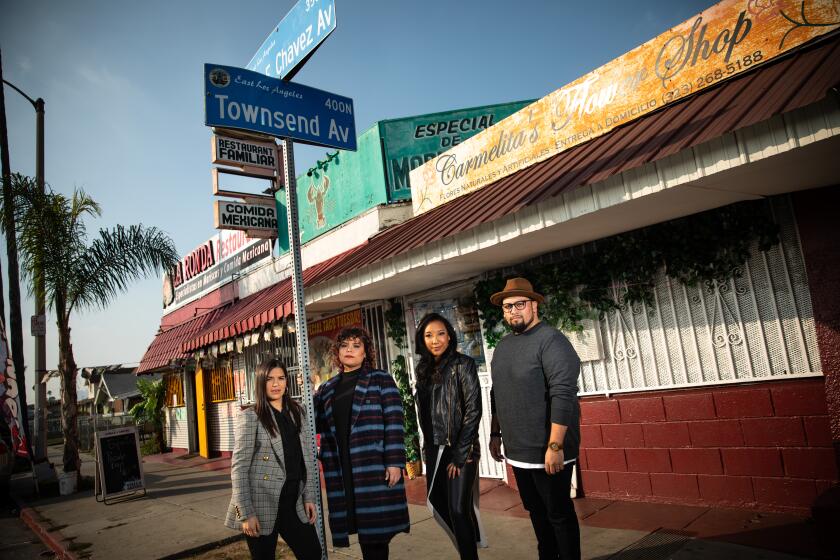The real star of Showtime’s new series? L.A.’s neglected Mexican and Chicano history
Segregation. Racism. Nazis infiltrating local government. Even for many Angelenos, the popular conception of the city’s history leaves out its darkest aspects. With the next iteration of “Penny Dreadful,” creator and showrunner John Logan plans to change that.
“When you think about Los Angeles history, you think of Hollywood, and that’s not what Los Angeles is,” Logan says while walking through the series’ late-1930s, pachuco-era Los Angeles set, located at the historic Melody Ranch studios. “I’m an Angeleno. I live here, I love this city. I love the neighborhoods of this city and I love the history of the city — particularly because people don’t necessarily know it.”
The man behind the original “Penny Dreadful,” which ran for three seasons and drew on famed figures from Gothic literature, has now taken an oft-forgotten piece of history, added the supernatural and the culturally specific iconography of Santa Muerte, and produced Showtime’s spinoff “Penny Dreadful: City of Angels,” which premieres Sunday.
Logan wanted to tell a story that “had to do with where we are now in 2020 and the seismic change that happened the world in the last five years,” he says. “All the assumptions I had made about liberal humanism, compassion and the democratic process were being circumvented everywhere and the marching cry of so much of this was anti-immigrant, and in America, particularly, anti-Latino and anti-Mexican.
“I started really researching the history of the freeways,” he continues. “I found that all of the freeways that were envisioned for the rich, white enclaves of Los Angeles were never built. [But] in East L.A., South Central L.A.? One hundred percent of those freeways got built. Obviously, you can’t tell the story of Los Angeles without telling the story of Mexican Americans, and you can’t tell the story of the freeways without telling the story of the communities of color that were displaced.”
Netflix’s “Gentefied,” executive produced by America Ferrera, confronts gentrification in Boyle Heights. Can it avoid contributing to the problem?
Immediately, Logan knew he wanted to tell a story about a Latino family. But, being Irish, he knew he had some work to do to make sure the story carried authenticity and wasn’t plagued with stereotypes or caricatures. (“As much as people say full-blooded Irish is like full-blooded Mexican, it’s not.”) In addition to his intensive research, he surrounded himself with people who would keep him “honest,” like Latinx writers Jose Rivera and Tatiana Suarez-Pico, directors Paco Cabezas and Roxann Dawson, and producing partner Michael Aguilar.
He also cast talent like Academy Award-nominated Mexican actress Adriana Barraza, whom costar Natalie Dormer calls “the heart and soul of the show.”
“The first time I spoke with John, I was really surprised by the care and good intentions he took to not folklorize Mexicans,” Barraza, who plays Maria, the matriarch of the season’s central Vega family, says in a phone interview.
Only one element gave her pause, and that was how Santa Muerte was represented. In Mexico today, Barraza noted, Santa Muerte has become a symbol for drug cartels, which she wasn’t comfortable with. Since her character is most connected to the sacred entity, she took it upon herself to research Santa Muerte, and discovered that “in the ’30s era, Santa Muerte was a blessed character that helps men get to God. It was a time where she was worshiped as a saint or a virgin and not with the connotation of drug trafficking. For me that is really important.”
“[Logan] put the Mexican community and their beliefs into a very deep and true dimension in the United States,” Barraza added. “The show acknowledges that they are no longer Mexicans, but they are Mexican Americans and Chicanos, which, as you know, is different. The show offers a Mexican perspective through my character, and a Chicano perspective through my kids on the show, and the suffering Chicanos went through and are still going through.”
Daniel Zovatto plays Tiago Vega, one of Maria’s sons and the first Latino detective in Los Angeles — a milestone that comes with mistrust from both his Mexican family and his police brethren. Tiago is constantly asked to define who he is: Is he a cop (i.e., will he assimilate) or is he a Mexican? It’s a sentiment many first- and second-generation Latin American children have grappled with, and one Zovatto, who emigrated from Costa Rica 10 years ago, knows all too well.
L.A. has always been key to Issa Rae’s “Insecure.” But now, with the city hunkered down amid the coronavirus outbreak, that love feels more vital than ever.
“I feel like in many ways I understand that struggle about who you are — if you’re more or less Latino because of whether you speak Spanish or not, or whatever. I think all of that is just owning who you are,” he says. “That’s one of the things that you’re going to see with Tiago. You know, this transitional phase of politics and all this chaos going around, and he starts to find his ground.”
Logan knew he also had to create a complex, endearing character to be Tiago’s partner and mentor, Lewis Michener. “He’s an incredible dramatic actor,” Logan says of Nathan Lane, who plays the character. “I knew I had to write Lewis for him.”
“I think [Lewis] was the only one who would partner with [Tiago] because there’s such racial prejudice on the force and I think not only does he respect this kid and think he has potential, but I think he also understands what it is to be an outsider,” Lane says.
“Game of Thrones” vet Dormer, who portrays several characters under the guise of Magda — the shape-shifting, devil-on-your-shoulder sister of Santa Muerte — describes “City of Angels” as a learning experience, much like the one Logan hopes to give the audience.
“I’ve been put in this highly educational and privileged position to really sort of step back and learn,” she says. “I’ve been coming to L.A. for 15 years now, and I knew it once was Mexico, but I didn’t know about the horrific things that happened fairly recently, like the illegal deportation of Mexicans” known as the Mexican Repatriation program, during the Great Depression. “To realize that I had this massive blind spot about an area I spend a lot of my time in was eye-opening.”
‘Penny Dreadful: City of Angels’
Where: Showtime
When: 10:10 p.m. Sunday
Rating: TV-MA (may be unsuitable for children under the age of 17)
More to Read
The complete guide to home viewing
Get Screen Gab for everything about the TV shows and streaming movies everyone’s talking about.
You may occasionally receive promotional content from the Los Angeles Times.







